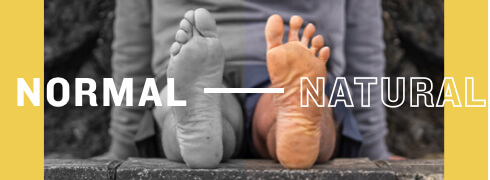We often get asked about whether barefoot footwear is suitable for flat feet. To show why people with flat feet can absolutely live barefoot, in this blog we explain:
- What flat feet are
- The relevance of foot strength
- How we build foot strength
- What the evidence says about barefoot footwear and flat feet
Let’s jump in!
What are flat feet, exactly?
A foot is considered ‘flat’ when its inside arch is flat rather than arched, meaning the whole sole touches the floor when standing. (We also have a blog on the opposite issue: high arches.) Flatfoot is a common, typically painless condition, and can result from genetics, injury, footwear or other lifestyle factors.
Because conventional podiatry (the branch of medicine devoted to feet) often suggests insoles to ‘support’ flat arches, many people with flat, or flat-ish, feet think barefoot footwear isn’t for them. But we don’t think this is necessarily true, and not just because we’re biased!
What matters isn’t arch height, but arch strength
Strong feet are less likely to experience pain or restricted movement. And while we’re all built differently, having flat feet doesn’t mean forgoing strong feet. The problem with orthotic insoles is that they restrict movement, immobilising arch muscles. This is more likely to weaken the muscles, not strengthen them.
How you walk (and run) has a big influence on foot strength
Living barefoot means using the muscles and tendons in your feet, including your arches, more. So if building foot strength is your aim, barefoot footwear could help. Walking or running barefoot is likely to result in landing on your mid-to-forefoot more, instead of your heels, with shorter strides and your feet under your hips. This will likely strengthen your foot muscles, including your arches, as they absorb the impact your heels once did.


There is evidence suggesting barefoot is beneficial for flat feet
We need more research in this area, but there is enough evidence to suggest that going barefoot could help prevent and manage flat feet.
One study of 2,300 children in Manipal, India, for instance, compared regularly shod and regularly unshod school kids. It found that regularly unshod kids had wider feet - a sign of foot strength - and presented with fewer flat feet, suggesting flat feet aren’t always genetic. Another study, by the University of Delaware and Harvard Medical School, found that increasing barefoot activity makes arches stronger and higher. And a third study, from Corban University, found that barefoot running reduces pronation - when the feet turn inwards – something people with flat feet tend to experience more.
This evidence doesn’t mean going barefoot will work for everybody with flat feet. But it does make barefoot a viable option, and dispels the myth that people with flat feet definitely can’t go barefoot. If you have flat feet and are interested in barefoot living, we recommend two important things: see a barefoot specialist, and take it slowly.




